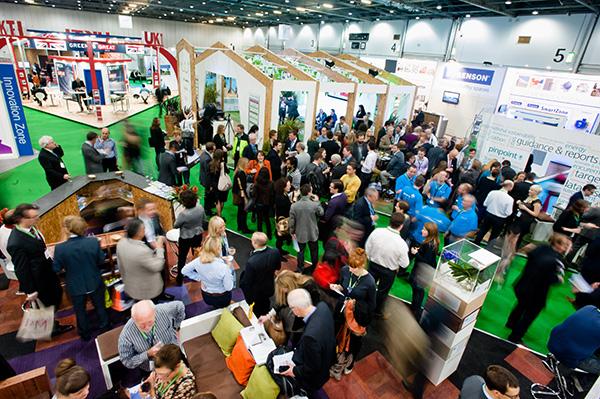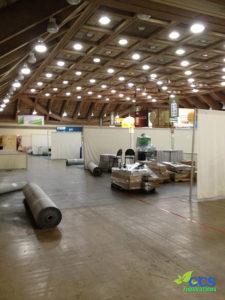Sooner or later most small business owners contemplate exhibiting at a trade show or special event. This crazy, hectic part of marketing often means long hours, significant investments, and confusing, paper-work driven details completely foreign to the average person. It can also be an outstanding way to present a business to a captive buying audience – as long it’s done correctly. Below are a few Trade Show Guidelines that have helped me succeed in the event world:
Picking the Right Show
 There’s no getting around the fact that trade shows and events are an expensive investment, with some costing well into the hundreds of thousands of dollars. While most smaller businesses won’t need to spend a fraction of that amount, when one factors in the cost of displays, collateral, the space itself, and staffing the booth, no event is an insignificant investment. This is why the first step in my Trade Show Guidelines is determining whether or not a show is right for your business through research and evaluation. Things I check before signing up include:
There’s no getting around the fact that trade shows and events are an expensive investment, with some costing well into the hundreds of thousands of dollars. While most smaller businesses won’t need to spend a fraction of that amount, when one factors in the cost of displays, collateral, the space itself, and staffing the booth, no event is an insignificant investment. This is why the first step in my Trade Show Guidelines is determining whether or not a show is right for your business through research and evaluation. Things I check before signing up include:
- Attendance Numbers: No matter how fantastic your booth space, understand that you will only speak with a (small) portion of the event’s attendees. Will the event offer enough traffic to make the show worth your while?
- Other Exhibitors: Will the exhibitor mix draw enough “quality” attendees? Will you be up against too many competitors? How many exhibitors will be in the hall: too few and attendees will skip over the hall, too many and it could be difficult to stand out.
- Show Draws: Are the speakers and break-out sessions enough to draw your target buyers?
- Show Hours: When is the exhibit hall open? Is it open long enough to warrant your time and money? This is a critical question: will the hall be open at the right times, allowing for meaningful sales conversations (i.e., not just first thing or at the end of the day)?
- Extra Costs: Depending on where the event is held, you may face extra costs such as union fees, electricity charges, maid service, furniture rentals, on-site storage, badge fees, etc. These charges can accumulate quickly and push the cost of the event out of your budget’s reach. Sadly, even the simplest of booth construction can be subject to these extras in union-run locations, at times tacking thousands to the original show cost. The key to surviving this money pit unscathed is reading all paperwork ahead of time and meeting the early bird rate deadlines.
 Setting Up A Booth Space
Setting Up A Booth Space
Next up in my Trade Show Guidelines is choosing and setting up your exhibit space. Event spaces can vary, depending on the show type and venue hall itself. Most small businesses end up with the standard 10′ x 10′ or 10′ x 20′ space, however, there times when exhibiting at shows with 5′ draped tables set end to end makes sense. While not necessarily an indication of business size, larger companies typically have larger spaces that require significantly more planning and work, including hiring installation teams. Regardless of the type, there are a few trade show basics associated with setting up any event space:
- Placement: the name of the game with any event is catching attendees’ attention quickly, meaning that choosing the right space can make or break an event. Very few businesses have a “profitable show” when stuck in the dark corner of an annex hall. Look at the show’s exhibit map and pick a place that has good traffic and allows you to show off your business to its best advantage. In general, it’s a good practice to pick the place yourself rather than leaving it up to the event’s staff as they’re often more interested in filling up a hall than selling your business.
- Clear Message. I’ve seen countless businesses create complicated, off-message themes within their booths only to wonder why they haven’t had meaningful business conversations with the right attendees. Gimmicky set-ups can pull people in, however, the gimmick has to be very simple, quickly grasped, and, most importantly, on brand message. If an attendee has to pause and really study your booth to understand it, your set-up’s too complicated.
- Professional Design Counts: A trade show booth is a reflection of your business itself, and amateur design can look “mom and pop” next to a professional’s cleanly branded work. Like it or not, an amateur booth setup will make your business seem small and insignificant in attendees’ eyes – and encourage them to walk on. With all the money spent on securing a space, staffing the booth, and even travel, it’s a shame to lose business due to poorly designed graphics and collateral. Do yourself a favor and hire a professional!
- Keep It Clean. An open, clutter-free layout is inviting and will help quickly deliver your business message and clean, professional signage and display layouts allow visitors to quickly grasp your message, review your product or service, and engage you in business conversations. Fewer displayed products are more effective as sales tools than throwing every option onto a cluttered table. Keeping the booth clean also applies to housekeeping: a tidy space is inviting, a dirty space is not.
- Product Front And Center: Most show attendees are reluctant to stop and walk into a booth space, meaning that if all of your products / service information is in the back of your booth or cluttered on a table with you standing in front, you’re exhibiting with a handicap. I like to keep a few teaser products at the very front of a booth on a high counter as conversation starters. Since I’m standing and smiling behind the counter, it’s an easy way to catch a passing attendees’s attention with, “Have you seen x product?” Standing behind the teasers has advantage that my back is never turned to the show floor (I can watch and catch prospects continuously), is less intimidating to passing attendees, and I can use the teasers as conversation fillers.
- Videos and Interactive Displays: These can be powerful tools, as long as they don’t block the business message. I like to put them on the sides of the booth with the center open for samples and staff. In larger booths, pillars and walls are excellent video spots.
- Light It Up: Dark booths don’t sell!
Working the Booth
Next up in my Trade Show Guidelines is working the booth itself. Plan on spending more time than expected at the show and in the set-up / break-down process.
- Standing vs. Sitting: My rule is to never sit in the booth while attendees are on the floor. It may sound brutal, but the booth is there to generate business, and nothing makes attendees walk past a space faster than a booth worker sitting down. I cringe every time I see booth workers pull out the chairs, especially during peak times. If you don’t have the energy to stand and sell, why should your buyers (who have been walking on painful floors), stop and talk? If you have a multi-day show planned, the one exception to the “not sitting down” rule is to perch / lean on a high stool that isn’t visible behind a counter set at the front of the booth.
- Wardrobe: Always wear comfortable shoes, even if you’ve sprung for extra carpet padding. Make sure your outfit is approachable, ready for work (such as moving collateral boxes or samples), and just a little more formal than what attendees are wearing. You don’t want to make attendee uncomfortable standing next to you in a formal suit or outlandish outfit. If the goal is to gain business, leave the sexy outfits at home – you’ll attract the wrong attendees and may miss real opportunities.
- Be Warm and Engaging: Smile at everyone! Business and referrals can come from all types of attendees.
Trade Show Etiquette
This part of the Trade Show Guidelines is an often overlooked but oh-so-important part of the event world. Some of my best business deals have come from fellow exhibitors later in a show who either hired me directly or referred me to friends. Knowing this, it’s always a smart policy to be respectful and helpful to your fellow exhibitors. With very few exceptions, trade shows and events are costly, both in dollars and time, and all exhibitors deserve an equal opportunity to shine. My no-no’s include:
- Interrupting Traffic Flow: Standing in front of your fellow exhibitors’ booths and / or blocking the traffic flow. An example is a next-door neighbor standing on the edge of the booth space or to the side of a table with a group of people, forcing traffic to by-pass your own booth. That’s potentially lost business and it’s uncool when they do it. Don’t do it yourself.
- Visual Blocks: Blocking your fellow exhibitors with signs, plants, graphics, or other obstructions is insensitive and rude. Larger shows may have a 4′ rule, meaning that nothing taller than 3-4′ can be placed greater than 4′ from the back of the space. It’s a good practice to make sure the hall’s visual lines are free for everyone. This Guideline applies to in-line or in-row booth spaces, not islands.
- Nuisance Marketing: One of my biggest exhibitor pet peeves relates to exhibitors who pollute the hall with music, videos with sound, scent-based displays, smoke machines, flashy lights, or anything that is distracting and inescapable by your fellow exhibitors. Just don’t do it.
- Break-Down Early / Set-Up Late: Be mindful of the show’s hours and make sure your booth is set-up and ready for visitors during the show hours. My rule of thumb is break-down doesn’t occur until the floor is cleared of visitors, and I’ve made many a deal from attendees wandering the halls after my fellow exhibitors have broken down. NEVER break down early. Many shows levy penalties on exhibitors inconsiderate enough to break down early, for good reason. Empty spaces create a negative atmosphere over everyone else still on the floor.
Conclusion
Trade shows and events can be a valuable part of business growth and sales, but one that requires careful planning, budgeting, and an understanding that they are hard work, not excuses to party and socialize. By following my Trade Show Guidelines, taking the time to pick the right event and investing the money into a professional set-up, your event investment will pay off in the long run!
Written by Bonnie Taylor, CCS Innovations, LLC’s Chief Marketing Strategist and author of the bestselling book, I Think I Need Marketing. Named one of 2014’s “Top 40 Digital Marketing Luminaries & Educators” by the Online Marketing Institute, Ms. Taylor has spent the last two decades focused on Strategic Marketing and has been instrumental in leading many small to mid-size businesses to growth awards and international expansion.
